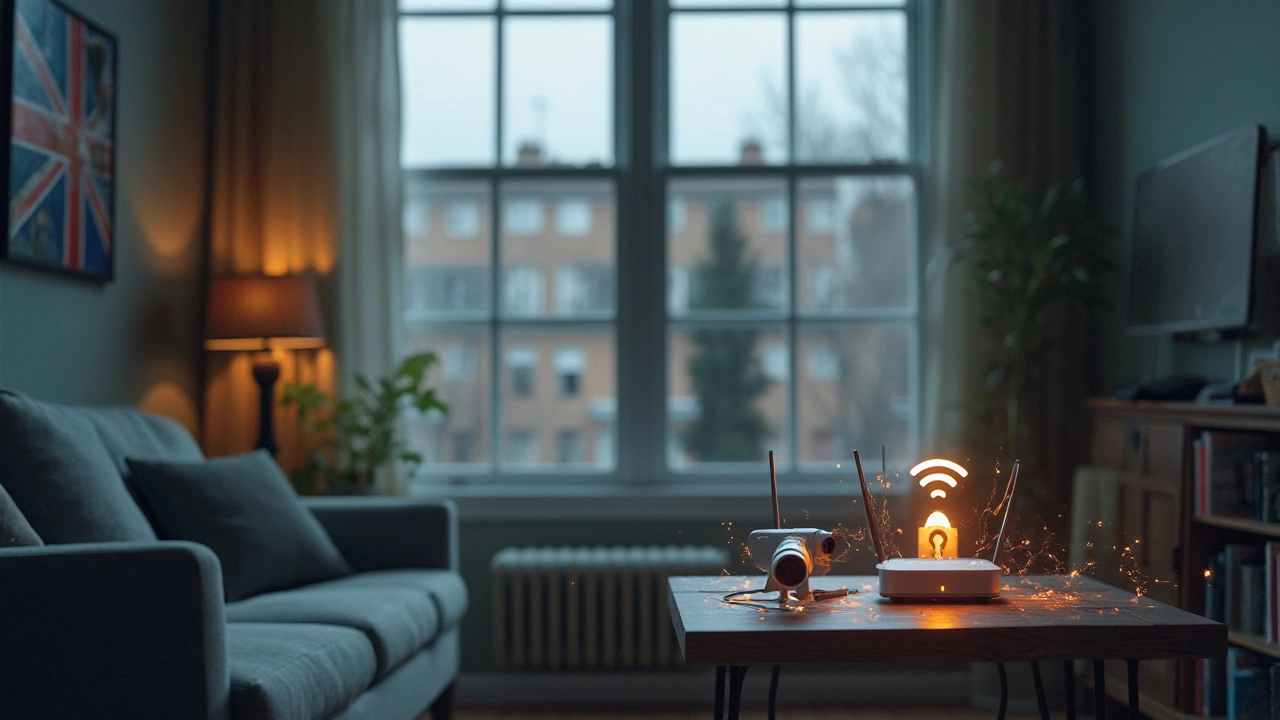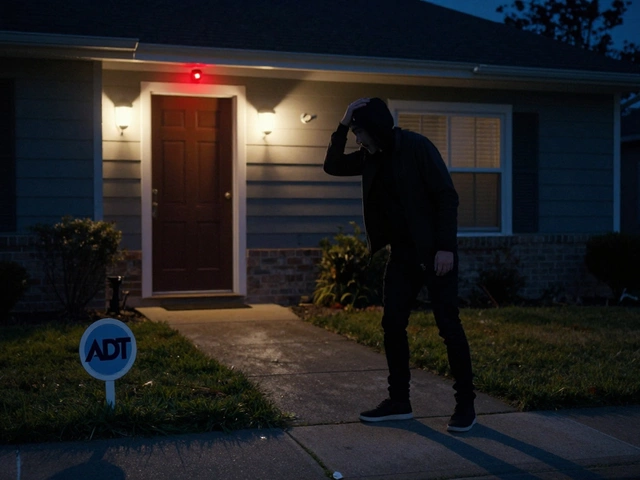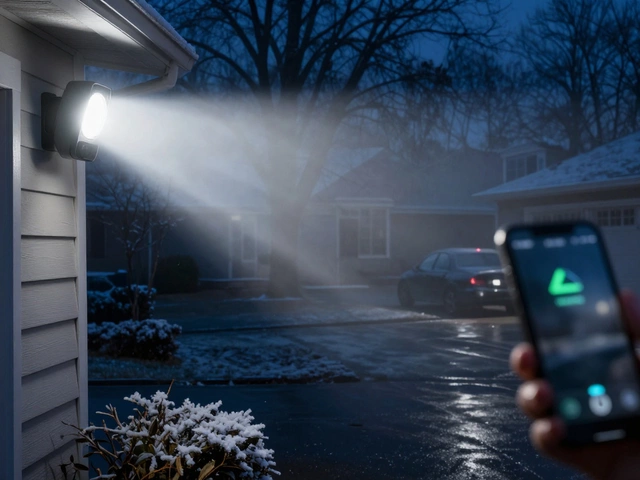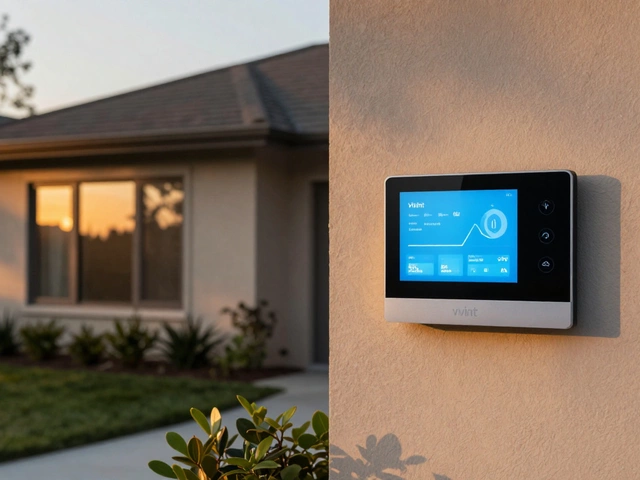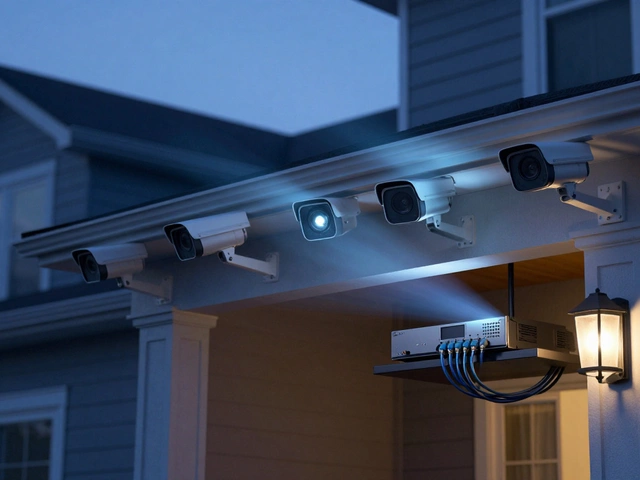Think your home security cameras keep you safer? That only works if your Wi-Fi isn’t rolling out the red carpet for anyone with hacking tools. The weak link is almost always your Wi-Fi settings—especially if you don’t know what all those protocol names and acronyms actually mean.
Here’s what most people miss: some Wi-Fi security options, like WEP, are practically useless. Millions of people still use them because they came set up by default, or the router’s a hand-me-down. But WEP can be broken in about 30 seconds with a free app.
That’s a nightmare for home security cameras, which stream video 24/7 and often have default passwords or shaky software. Someone grabs your Wi-Fi? They can watch, reset, or mess with your cameras—and you probably won't even know they're in.
Don’t trust old advice or the 'it’s working, so it must be fine' mindset. Hackers aren’t just bored teens these days—there are tools anyone can download in minutes. If your cameras are sitting on a network locked by outdated tech, you’re not protected, you’re basically inviting guests who never knock.
- Why Your Wi-Fi Security Matters for Cameras
- The Outdated Protocols You Should Never Use
- How Hackers Crack Weak Wi-Fi
- Best Security Settings for Peace of Mind
- Simple Fixes to Upgrade Your Network
- What If You Can't Change Everything?
Why Your Wi-Fi Security Matters for Cameras
When it comes to home security cameras, your Wi-Fi is as important as the lock on your front door. If the Wi-Fi is weak or outdated, anyone who sneaks past it can get a front-row seat to your daily life. That’s because most cameras connect straight to your home network and send their video over the Wi-Fi non-stop.
If your Wi-Fi is using an old or weak security protocol, like WEP, someone can get in with almost zero special skills. In 2019, a university study showed high school students learned to hack WEP in under 20 minutes on a classroom laptop. Once inside, they had the run of the smart devices—including cameras, lights, and even the door lock.
Why does this matter? Security cameras often have apps and settings that aren’t designed to stand alone against attacks. A hacker can:
- View your live video feeds, basically spying on you in real time
- Download stored footage or screenshots without your consent
- Turn off cameras or change alerts, so break-ins go unrecorded
- Steal passwords or data from other things on your network
It’s not just big businesses that get targeted either. Home hacks happen every day because regular folks leave their Wi-Fi security wide open without knowing it. According to a 2023 survey, over 18% of home networks still use old protocols that can be hacked in minutes. That’s a huge problem when every smart device—from baby monitors to front door cameras—is connected to the same Wi-Fi.
If you value your privacy (and if you’re using cameras, you already do), locking down your Wi-Fi should be priority number one. Skip this, and you might as well hand out the keys to your entire tech life.
The Outdated Protocols You Should Never Use
If your Wi-Fi security is set to WEP or even the original version of WPA, you're basically leaving the front door wide open. These protocols weren't built for today's world, and anyone with basic know-how can crack them in minutes.
WEP (Wired Equivalent Privacy) is the oldest—and the easiest to hack. This was the standard in the late 1990s. Security folks have known for over 20 years that WEP is broken. There's a free tool called "aircrack-ng" that can break WEP in under a minute. That means your home security cameras could be watched or even hijacked by someone sitting in a car down the street.
Then there's plain old WPA (not WPA2 or WPA3). It was brought out as a quick band-aid for WEP, but it didn’t age well. Vulnerabilities like the TKIP flaw make WPA almost as bad as WEP. Any serious attacker can break it using Wireshark, Reaver, or a handful of other tools. A 2022 security report from AV-TEST showed that networks still using WPA saw six times more successful intrusion attempts than WPA2-protected networks.
Here's how the weak standards stack up:
| Protocol | Year Introduced | Still Safe? | Time to Crack |
|---|---|---|---|
| WEP | 1997 | No | Less than 1 minute |
| WPA (TKIP) | 2003 | No | Minutes to hours |
| WPA2 (AES) | 2004 | Yes | Not practical |
| WPA3 | 2018 | Yes | Currently no known attacks |
If your router menu shows options like "WEP" or just "WPA", skip them. They’re there because of old hardware support, not because they’re actually safe. For anything involving home security cameras, you need to pick either WPA2 (with AES encryption) or WPA3 if your router and cameras support it. Anything else is just waiting for trouble.
- Never use WEP or plain WPA for your Wi-Fi security.
- Check your router settings and update the protocol to WPA2 or WPA3.
- If your camera only works with older protocols, it’s time to upgrade your gear—no excuses if you care about privacy.
How Hackers Crack Weak Wi-Fi
If you’ve got your Wi-Fi security set to WEP or even WPA, you might as well hang a sign that says “Free Wi-Fi for Hackers.” Seriously, these outdated protocols are stunningly easy to break. Let’s get into what makes them so vulnerable—and how attackers actually break in.
WEP (Wired Equivalent Privacy) is like the floppy disk of network security. It was already considered weak in the early 2000s, but some routers still ship with it set as the default. The flaw? WEP reuses "keys" (the password behind the scenes) way too often, and its encryption math is just too simple. With a tool like Aircrack-ng—something any middle schooler can download and run—hackers listen in on your Wi-Fi traffic and grab enough data to crack your password in under a minute.
WPA (Wi-Fi Protected Access, the original) isn’t much better. While WPA fixed a few things, real-world attacks like the "TKIP attack" can break into WPA networks in just an hour or two with free software. WPA2 with "AES" is way stronger, but WPA2 using "TKIP"? Also risky and not fully secure these days.
Here’s how a basic attack works on weak Wi-Fi:
- Hacker drives by your house or sits nearby (think coffee shop range).
- They run a program (like Reaver or Aircrack-ng) to capture what's called a "handshake"—this is just a bit of data your router gives off when a device connects.
- With WEP, they collect a few minutes of traffic and the tool spits out your Wi-Fi password, no sweat.
- With WPA, they try to guess your password over and over—usually with a big dictionary of common passwords.
- If your network uses a default or simple passphrase, they’ll get in even faster.
You think it’s rare? It’s not. Researchers once drove through San Francisco and found that around 3 in 10 home networks still relied on weak encryption. Now, attackers can even automate this stuff. Stick a cheap Wi-Fi hacking kit in a backpack, walk down the street, and in a few hours, someone could have the keys to dozens of networks.
| Protocol | Time to Crack |
|---|---|
| WEP | Less than 1 minute |
| WPA (with simple passphrase) | Minutes to hours |
| WPA2 with TKIP | Possible in hours |
| WPA2 with AES/strong password | Years (practically unbreakable) |
Once inside your Wi-Fi security, hackers can snoop around for your camera’s password or grab video footage directly. They can also play with your other smart devices. So, leaving old protocols running isn’t just a tech problem, it’s a real-world risk.

Best Security Settings for Peace of Mind
If you want your home security cameras—and everything else in your house—locked down, it’s all about using the right Wi-Fi security settings. Skip the jargon: here’s what actually works today.
The gold standard right now is WPA3. It’s the latest and strongest protocol for wireless security. If your router and devices support it, always choose WPA3-Personal. Not every camera or gadget is on board yet, but new ones almost always are, especially brands released after 2021. If your gear won’t support WPA3, go with WPA2-Personal (sometimes listed as WPA2-PSK) and make sure you avoid mixed modes like "WPA/WPA2." Mixed mode looks handy but lets older, weaker protocols sneak in.
| Protocol | Status | Use? |
|---|---|---|
| WPA3 | Current Best | Yes, if all devices support |
| WPA2 | Secure | OK if WPA3 not available |
| WPA/WPA2 Mixed | Weaker | No, avoid if possible |
| WEP | Obsolete | Never |
If your router has an option called Enterprise mode, skip it for home use. It’s built for offices with IT support. Stick to Personal/PSK modes—they’re easy and safe at home.
Don’t just take my word for it. The Wi-Fi Alliance recommends,
"For the strongest protection of home networks, enable WPA3 wherever possible. When all devices support WPA3, disable legacy protocols to reduce attack risks."
Here’s a quick checklist for nailing your settings:
- Pick WPA3-Personal. If not, use WPA2-Personal only.
- Set a long, random passphrase (at least 12 characters—mix letters, numbers, and symbols).
- Disable WPS (Wi-Fi Protected Setup). It’s a weak spot.
- Update your router's firmware regularly. This plugs security holes as soon as they’re found.
- Turn off any guest or legacy network options you don’t need.
Most people stick with default settings—but just a few tweaks make it way, way harder for someone to mess with your cameras. Your home security cameras work best on a locked-down, modern network. Don’t give hackers an easy win.
Simple Fixes to Upgrade Your Network
Ready to stop stressing over hacks and get your home network locked down? You don’t need a computer science degree. These fixes are fast and make a big difference, especially if you use Wi-Fi security for any type of home device, like home security cameras.
- Dump WEP and WPA: Go into your router’s Wi-Fi settings and check the security option. If it says WEP or even just WPA, change it right away. Set it to WPA2 or WPA3. These are actually built to stop easy hacks.
- Set a strong Wi-Fi password: This isn’t the place for "password123" or your dog’s name. Use at least 12 characters with a mix of uppercase, lowercase, numbers, and symbols.
- Update your router: Routers need firmware updates just like your phone. Log into the router admin (usually 192.168.1.1 or similar in your browser) and look for a firmware upgrade. This can slam the door on new vulnerabilities.
- Separate your devices: If possible, create a guest Wi-Fi network just for visitors. Put your home security cameras on a separate network or VLAN if your router allows it. This keeps your main network safer.
- Turn off remote access: Many routers let you log in from anywhere online. Unless you have a real reason, turn this off in your router settings so outsiders can’t mess with your setup.
If you’re wondering how many folks actually mess up here: Recent surveys have found that almost 60% of home Wi-Fi setups are still running outdated security like WPA, WEP, or none at all. That leaves millions open to attack. Just upgrading to WPA2 or WPA3 on your network can move you off that list instantly.
| Security Type | Easily Hackable? | Use in 2025? |
|---|---|---|
| WEP | Yes | No |
| WPA | Yes | No |
| WPA2 | No | Yes |
| WPA3 | No | Yes |
You don’t need fancy equipment or a big investment to do any of this. Just log in, tweak a few settings, and your cameras—and everything else—are way harder to mess with.
What If You Can't Change Everything?
Sometimes you’re stuck with the router you’ve got—maybe it’s from your internet provider, or it just won’t upgrade no matter what you try. Maybe your Wi-Fi security options are limited, but you still need those home security cameras running. Don’t panic. You’ve still got options to lock things down tighter, even if you can’t hit that perfect setup.
First, set the strongest security your router allows, even if it’s not WPA3. If you’re forced to use WPA or even WPA2 (which is still way better than WEP), activate it and kill off WEP entirely if you see it. Never pick an “open” network—ever. No password means anyone driving by can connect. If you can force it, set a long, random password for your Wi-Fi. Short, simple ones are too easy to brute-force.
If you can, segment your network. Some routers let you split things up—one network for your stuff, another for guests. Put those home security cameras on their own network if possible. That way, if someone cracks the guest Wi-Fi, they can’t wander over to your cameras.
Think about updating your camera firmware. Companies push out updates for a reason—sometimes they patch up security holes so big, even basic hacking tools can get through. Always check the app or web interface for updates every month or so.
Disable remote access unless you really need it. If your cameras offer that feature, hackers see it too—and they’ll try to log in from anywhere in the world. The same goes for Universal Plug and Play (UPnP) on your router. It’s meant for convenience, but it often ends up as a big open door.
Here’s a dead-simple win—rename your Wi-Fi network (SSID) to something boring and unidentifiable. Don’t use your family name or tell everyone what brand of router you have. Make it look as generic as possible. Hackers love finding networks screaming “SmithHome” or “BabyCam2020.”
Want to know how common weak security still is? Here’s a quick snapshot based on a 2024 study by Security.org:
| Wi-Fi Security Type | % of U.S. Households (2024) |
|---|---|
| WEP | 5% |
| WPA | 24% |
| WPA2 | 59% |
| WPA3 | 12% |
So yeah, millions are still on WEP or WPA—and that’s risky for home security cameras streaming from living rooms and driveways everywhere.
If you truly can’t get better security, consider plugging your cameras directly into your router with an Ethernet cable, if they support it. Wired connections dodge most common Wi-Fi security attacks and aren’t as easy to snoop on.
The bottom line? Even with weak Wi-Fi protection, you can still make life harder for hackers. Layer up defenses—strong passwords, firmware updates, network segments, and as little public info as possible. It’s not perfect, but it keeps you a step ahead until you can get a proper upgrade.

